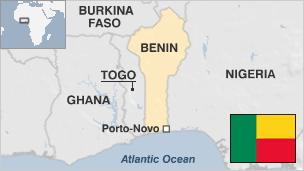

-
4 June 2015
- From the section Africa

Benin, formerly known as Dahomey, is one of Africa’s most stable democracies.
It boasts a proliferation of political parties and a strong civil society.
On the economic side, however, the picture is less bright – Benin is severely underdeveloped, and corruption is rife.
Benin’s shore includes what used to be known as the Slave Coast, from where captives were shipped across the Atlantic. Elements of the culture and religion brought by slaves from the area are still present in the Americas, including voodoo.
Once banned in Benin, the religion is celebrated at the country’s annual Voodoo Day, which draws thousands of celebrants.
Before being colonised by France towards the end of the 1800s, the area comprised several independent states, including the Kingdom of Dahomey, which had a well-trained standing army and was geared towards the export of slaves and later palm oil.
Instability marked the first years after full independence from France in 1960 and the early part of Mr Kerekou’s rule featured Marxism-Leninism as the official ideology.
However, during the 1980s Mr Kerekou resigned from the army to become a civilian head of state and liberalised the economy.
While Benin has seen economic growth over the past few years and is one of Africa’s largest cotton producers, it ranks among the world’s poorest countries. The economy relies heavily on trade with its eastern neighbour, Nigeria.
To the north, there have been sporadic clashes along Benin’s border with Burkina Faso. The trouble has been blamed on land disputes between rival communities on either side of the border.
Thousands of Togolese refugees fled to Benin in 2005 following political unrest in their homeland. Benin called for international aid to help it shelter and feed the exiles.


